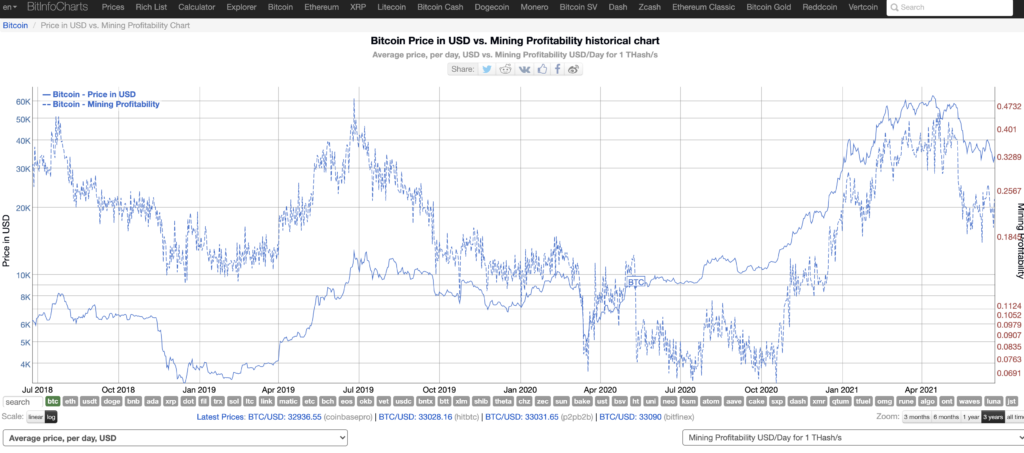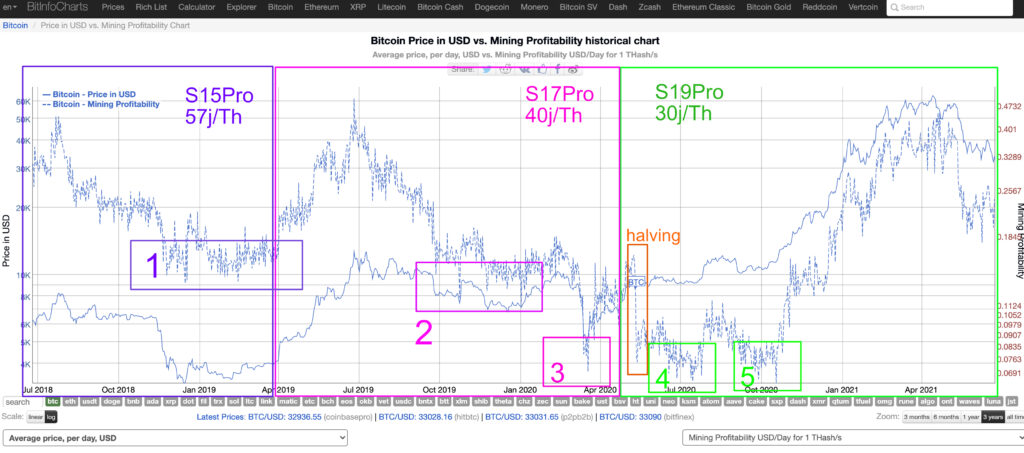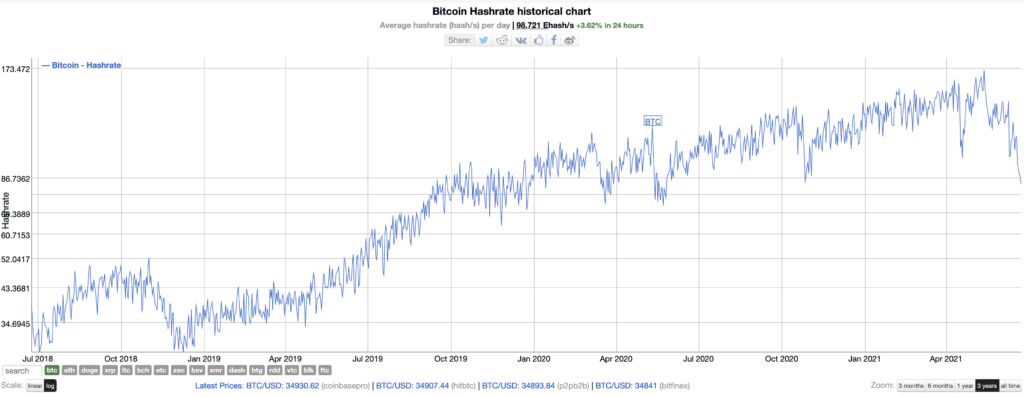Analysis of the relationship between the price of bitcoin and the profitability of mining.
Все новости про Zcash в социальной сети «X» (бывший Twitter) | Интересные видео про Zcash на YouTube
As an introductory explanation, I will give an excerpt from my article (source in Russian).
«The cost of mining in PoW algorithms (for example, Bitcoin).
Consider from the point of view of costs the process of receiving a reward for a found block in POW algorithms. Few private miners are trying to mine cryptocurrency solo (without registering through pools), since the probability of closing a block on a small amount of equipment is practically zero, but the costs will be incurred in the same amount. What costs are we talking about? In addition to the cost of electricity, first of all, it is necessary to take into account the cost of the equipment itself. If we are talking about bitcoin, then this equipment based on the use of integrated circuits for computing is maximally optimized for mining in a strictly defined calculation algorithm — in our case it is SHA256. In the «people» such equipment is called ASIC.

Current (current generation) ASIC hardware is not cheap.
On average, its current market price is correlated according to the formula: daily profitability at the current moment multiplied by 100-180 (days).
But at the same time, the ASIC has a very short life cycle.
But at the same time, ASICs have a very short life cycle. As a rule, one, maximum two years (during periods of decline in the cost of bitcoin and, as a result, with less interest of miners in purchasing new equipment). All manufacturers are constantly working on the efficiency of their devices.
During periods of growth in the value of cryptocurrencies, the bitcoin hash rate can double every six months or even faster, which means that the initial calculations of the return on investment for the purchase very quickly lose their relevance. At some point, bitcoin quotes make mining unprofitable so that even without taking into account the cost of equipment, the cost of electricity becomes higher than the cost of the coin itself — which means it becomes easier to buy a coin from the market, and not continue mining. As a rule, during such a period, the network hash rate begins to decline and only large players with access to the cheapest electricity or the most technologically advanced and energy-efficient equipment of the latest generation can withstand competition. However, when the price of bitcoin sharply rushes upwards, almost already decommissioned ASICs are included in the work. As a result, during such periods, the hash rate updates historical highs, often together with the value of the first cryptocurrency. Halving — halving the miners’ reward every four years certainly contributes to this process, forcing the owners of very old ASIC miners to literally hand over the iron for scrap metal, which instantly became ineffective.

Speaking about the cost of mining, one cannot but consider the second most important component of costs — electricity. At the time of this writing, the flagship for mining is the S17 miner from the largest equipment of the Chinese ASIC manufacturer Bitmain, built on 7nm chips. These devices consume 45 watts per hour, based on the power of 1 terahesh per second and according to this indicator, the best energy efficiency of the devices on the market. Based on the current level of global hashrate in the Bitcoin network, the performance of one coin on these devices will require about 28 thousand kilowatts of electricity (the value is constantly subject to fluctuations). Undoubtedly, this is a serious energy consumption. Even taking into account the fact that there is a territory in the world where the production of electricity is relatively inexpensive and at the same time there are sufficiently large capacities. to realize crypto income at a bargain price and without taking into account the average market cost of electricity for mass mining — a rather naive thought. By the way, infrastructure is also a significant part of the costs of this business. In an open field with only ASIC devices, it will not work to extract crypt. It is necessary to rent territory, base substations, containers or hangars, organize proper cooling and maintenance of premises and equipment. As a result, mining requires large capital and additional costs.

HASHRATE AND BITCOIN PRICE IN US DOLLARS. IN BOTH CASES USED A SIMPLE SLIDING AVERAGE ON A LOGARITHMIC SCALE
To deny the dependence of these two processes: the involvement of miners in the mining and price of bitcoin — is impossible. It is enough to superimpose these two graphs one on top of the other and their correlation will become obvious. Not surprisingly, when the very first bitcoin trading was launched, the NewLibertyStandart service participants suggested using the cost of electricity spent on generation to estimate bitcoins in October 2009, which are designed for a process that is only 1,309.03 bitcoins per dollar.
All this fits into the concept of parabolic cycles of growth in the value of bitcoin and is roughly the following chain of events:
→ Due to speculative sentiments and rush demand, the price shows new historical values. (1)
→ Mining becomes super-profitable and attracts new participants, there is a change of generations of mining equipment. (2)
→ The hashrate increases, the reward per conditional unit of power decreases. (3)
→ After the rush demand is satisfied, the trend of the bitcoin price changes from growing to downward. (4)
→ The equipment continues to work until the price is limited by the production cost. (5)
→ Inefficient equipment goes out of production, hash rate starts to decline. (6)
→ The offer for the sale of coins from the new issue, received as a mining reward, is significantly reduced due to the low profitability of mining. (7)
→ The value of bitcoin finds an equilibrium value and begins to stabilize (the longest period). (8)
→ The proximity of halving warms up the market for the beginning of a new speculative cycle. (9)
In this chain, it is also necessary to note three important factors that also affect the patterns of the cycle and the correlation of the graphs:
- Deliveries of new equipment are made on full prepayment with a certain time delay. This point is very important from the point of view of the fact that no matter how the value of the coin has changed over the period of delivery of the equipment, it will be included in the mining and will affect the hash rate of the network (the decision is made at the time of payment, and the equipment downtime has no economic sense, because it is new and effective).
- ASIC was specially designed and designed for a strictly defined algorithm. Unlike GPU mining, the miner does not have much choice about what to do with his equipment and there are no options for universal migration from algorithm to algorithm — an ASIC can either mine a certain cryptocurrency or not mine it at all. As I already noted, it is economically expedient to continue mining until the cost of the coin is lower than its value (in each specific case and under certain conditions, the price of electricity).
- By the beginning of each new cycle, the hash rate and coin value significantly exceed the previous indicators at the beginning of the last cycle.
I will summarize this part of the article with two theses:
- POW mining, due to the presence of costs, creates the cost of mining a coin and is a conditional guarantor of price stabilization during a bearish trend.
- POW mining creates the added value of a new issue while increasing the total cryptocurrency capitalization.
I will summarize this part of the article with two theses:
1. PoW-mining, due to the presence of costs, creates the cost of mining a coin and is a conditional guarantor of price stabilization during a bearish trend.
2. PoW-mining creates the added value of a new issue while increasing the total cryptocurrency capitalization.»
So..
I especially want to note that the events of the cycle described by me in this article (written in May 2019) were carried out exactly.
Let’s take a closer look at this graph.

It presents:
- Bitcoin Price — is the blue line, the scale of divisions on the left in thousands of dollars;
- Mining Profitability (MP) for one conditional THash/s-the value of which is derived from the current values of the coin price (Price), the total hashrate per second (Hashrate) and the reward of miners (Rewards) in the form of a new issue for one day. MP = ( Price * Rewards * THash/s ) / Hashrate — blue dotted line, the division scale on the right in dollars;
- For greater convenience of comparison and accentuation of the considered zones, a logarithmic method of displaying the scale is chosen.
The price value available in both charts of course causes some correlation of these two graphs. However, for the analysis that I propose, correlation does not have a role.
But an important role is played by the value «ZERO» on the scale of divisions on the right and the time intervals during which MP approaches zero as much as possible. And I also suggest focusing on the behavior of the price in these intervals.

Now I will provide explanations.
From the point of view of mining profitability, it makes no sense to consider events without taking into account the current generation of ASICs presented on the market. Therefore, I have identified three blocks, taking into account the start of deliveries of each new generation of the main equipment manufacturer — Bitmain. The fact is that each new generation of the S-series improves its efficiency (increases productivity by 1 watt of electricity spent) by about one and a half times. Over a large time interval, this will mean that profitability in absolute values by 1 terahesh will be reduced due to increased efficiency. Therefore, when comparing the segments of the graph, it is important to take this into account. Of course, the replacement of equipment does not happen instantly, but it happens.
Now I will focus on the explanation of blocks 1-5.
Block №1 The period from the end of November 2018 to the end of March 2019.
The price of bitcoin, despite the strong bearish sentiment and the capitulation of a large number of new crypto users who entered the market in 2017 (there are many opinions on the market that bitcoin is going to zero), is stabilizing at the range of $ 3500-4000. At lower prices, miners stop selling. The hashrate has fallen from the peak values of 50+ EHash to 30-40 EHash (the graph is presented after the description of all blocks). This is a fairly long period, which in the cycle of the article I call «the value of bitcoin finds an equilibrium value and begins to stabilize (the longest period)«. The next part of the cycle: «the proximity of halving warms up the market for the beginning of a new speculative cycle«.
Block №2 The period from October 2019 to February 2020.
The price recovery coincided with the start of deliveries of the new flagship Bitmain S17Pro. The hashrate against the background of deliveries reaches a new historical high of 115 Hash. The owners of the previous generation of ASICs stop making a profit, the price of$ 7000 does not suit any of them anymore. Profitability is again close to the minimum. The price of bitcoin begins to push off again and goes to the area of 10 thousand dollars, until the brewing crisis caused by a new threat to humanity COVID-19 intervenes. And we get to block number 3.
Block №3 March 2020.
The liquidity crisis is sweeping away the markets. Oil goes into negative territory, stocks lose 50% and more a day. The cryptocurrency market is no exception. Black swan in its purest form — in the middle of March, the price could have absolutely any value. These days, I made purchases, realizing that the market will level out precisely the fact that the cost of production of one bitcoin was higher than the current levels. This means that the offer will soon completely leave the market. And so it happened. In April, the price stabilized. In May, deliveries of the new S19 Pro began, and the halving again made mining unprofitable. Bitcoin begins a new growth cycle.
I will combine blocks №4 and №5, because they are similar to two twin brothers, only at different hashrate levels.
If in July 2020 the hashrate revolves around 100 Hash, then in October it is more than 120 EHash. In both blocks, the miners are not in the comfort zone. Due to the recent halving, their profitability is at historically low values, comparable to the minimum of Black March. The growth of the bitcoin price, due to a significant reduction in supply, will continue, in which the stage of hype demand will not take long to wait. In May 2021, we saw the peak of this demand and it seems that the cycle is coming to its end.

And what’s next?
What can we expect now? I am concerned about the news about the ban on mining, the pressure around the environmental consequences of mining, and there is a shortage of chips needed for a new series of equipment. The shortage is caused by the fact that the only company that is able to produce an improved generation of chips ordered by Bitmain (S21Pro based on 5nm technology) — the Taiwanese corporation TSMC is fully engaged in supplying chips for Apple’s new M1 processors. There is no understanding how long this deficit will last, and this is a problem for starting a new cycle (1). But I know that sooner or later we will see the announcement of S21Pro, which will again have an impact and in the case of a bear market will stabilize the price of bitcoin at the level of minimum profitability that will suit miners.
All I want to demonstrate is that we are able to roughly understand the price bottom of bitcoin thanks to these processes. Because market economic processes in conditions of decentralization, as well as the disparate, but generally the same psychology of people, make these cycles a natural development of the spiral. And only thanks to the PoW-algorithm of Bitcoin that this market will continue to live on until there is a stronger motivation. Such motivation as, for example, an unhindered and convenient opportunity to pay for goods and services with cryptocurrency in most of the developed economies of the world.
Все новости про Zcash в социальной сети «X» (бывший Twitter) | Интересные видео про Zcash на YouTube
Вы можете поддержать автора проекта pro.zcash:
(для отправки доната на данный адрес требуется
кошелёк с функционалом экранированных транзакций)
